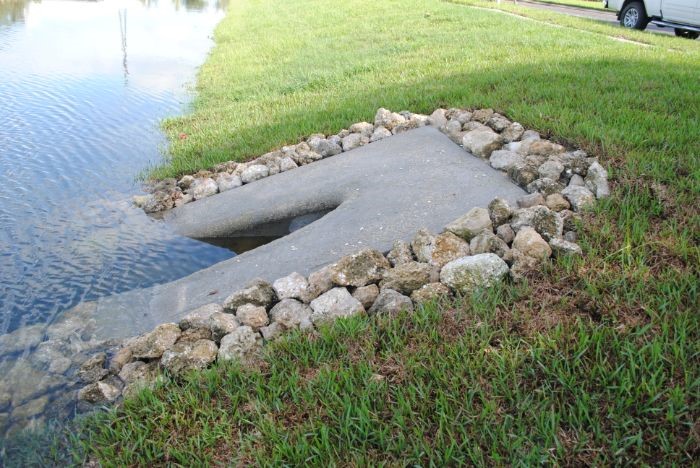A critical component to every community, golf course, development or municipality, is the functionality of its stormwater management system. The stormwater management system is designed to allow for proper drainage, storage capacity, and for a safe discharge into the master system.
Maintaining a stormwater management system is paramount. Over time, erosion can cause sedimentation to occur, leading to decreased storage capacity, unsafe slopes and instability along embankments. Erosion and sedimentation can also cause undermining and cracking around drainage structures such as pipes, weirs and control structures, which are essential to the function of the system.
Working with a variety of clients, the main concern with maintaining stormwater management systems is the liability risk. Instability along the shoreline poses a great threat to homeowners and stormwater infrastructure. As erosion nears structures such as homes, roadways, and stormwater infrastructure, action must be taken to stabilize the embankment.

Know the signs
There are a variety of eroding forces that contribute to the weakening of an embankment. Understanding which eroding factors are at play are key to the success of any repair efforts and preventing future erosion.
Fluctuating Water Levels are common across Florida’s landscape. These changes can be the result of natural processes or man-made intervention, such as well-fed systems, failure in stormwater management infrastructure, or site dewatering for developmental purposes. During high water levels, the embankment becomes saturated and if given enough time, will drown vegetation along the shoreline. As water levels reach a low point, the embankment is now exposed and vulnerable to rain (or water) erosion. During the transition between these events, the embankment is in a weakened state as saturation has weakened its soils. When performing repair efforts, an understanding and account for these levels are crucial to success.
With the high rainfall events we experience in Florida, Sheet Flow erosion is a major occurrence. As water seeks to drain to our lakes, ponds, rivers and streams, the force at which it races can remove finer particles of soil and result in rills and gulleys along the embankment. These events are common at water consolidation points such as swales, spillways, and along steep embankments.
Wave and Wind Action is a natural eroding process that seeks to weaken embankments. This continuous process of pounding the embankment may result in undermining and loss of stability. This type of erosion is primarily seen along beachfront or intracoastal areas, canals, and large lake systems.
As infrastructure ages, the risk of failures increases
Stormwater management system infrastructure plays a vital role in safe drainage and flood control. As these components age, it increases the likelihood of pipe corrosion, embankment erosion, sedimentation, and other failures. These failures may result in flooding, road damage, collapsing embankments and sinkholes. Keeping tabs on these structures are important to avoiding costly repairs at emergency rates. The stormwater management system should be regularly inspected, and any potential blockages, cracks, unsafe slopes and sediment build-up be properly managed to control erosion.

At Landshore® Enterprises, LLC, our team of highly qualified engineers, certified stormwater, erosion and sedimentation inspectors, and construction staff, is available for assistance in maintaining your stormwater management system. If you’re interested in learning more about our services, please contact us at (941) 303-5238 or via email at Info@landshore.com.
Regards,
Landshore® Enterprises, LLC
Shoreline Restoration and Erosion Control Specialists
